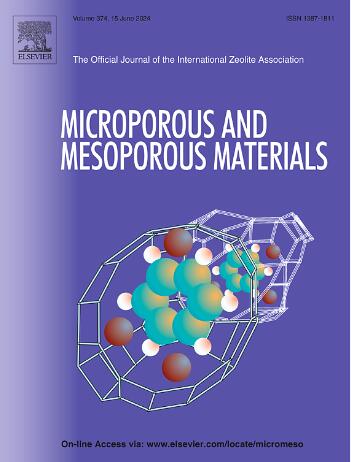Selective hydrogenation of dienes to olefins and sulfur removal from model FCC gasoline over Ni-Mo sulfide catalyst supported on MCM-41 type silica
IF 4.8
3区 材料科学
Q1 CHEMISTRY, APPLIED
引用次数: 0
Abstract
The transformation of 2,5-dimethyl-hexadiene-2,4 and benzothiophene over mesoporous MCM-41 silica supported Ni-Mo sulfide catalyst was estimated. The physico-chemical properties of support and catalyst were evaluated by XRD, low-temperature N2 adsorption, TEM, EDX mapping and XPS analysis. The catalyst reveals the sulfide particles with 5.4 nm in length and 3.5 stacks supported on MCM-41 silica having hexagonal porous arrangement with 2.5 nm in diameter. The effective content of Mo in MoS2 was 48.3 wt%. According to thermodynamic calculations, the equilibrium mixture contains 2,5-dimethylhexane (82 %) and n-octane (18 %). For catalytic tests, at 260–340 °C for 1–2 h selectivity to olefins reaches 85–90 %, whereas 100 % benzothiophene conversion to ethylbenzene was achieved at 300–340 °C for 6–10 h. n-Octane was detected as the product of skeletal isomerization of 2,5-dimethyl-hexadiene-1,5. For model FCC gasoline, the optimal conditions providing effective sulfur removal and selective hydrogenation were defined as 300–320 °C and 2–4 h under 3–5 MPa hydrogen pressure. The reusability of the catalyst was evaluated using model feed containing BT and C8H14 with molar ratio of 2:1 under 5 MPa hydrogen pressure at 320 °C for 2 h without any pre-treatment or regeneration of the catalyst before the next reaction run. In was established that HDS/HYDO selectivity increases with reaction run, which is due to the conversion of C8H14 decrease more significant as compared to that for BT, whereas conversion and product distribution maintain unchanged from 5 reaction run, indicating that the catalyst is running-in. For the spent NiMoS/MCM-41 catalyst the effective content of Mo in MoS2 phase reaches 42.8 wt%, whereas that for Ni in NiS and NiMoS phase was 1.7 wt% and 0.7 wt%, respectively, which is compared to those values for the fresh sample.

MCM-41型二氧化硅负载Ni-Mo硫化物催化剂对模型FCC汽油中二烯选择性加氢制烯烃及脱硫的影响
估计了2,5-二甲基己二烯-2,4和苯并噻吩在介孔MCM-41二氧化硅负载的硫化镍催化剂上的转化。采用XRD、低温N2吸附、TEM、EDX作图和XPS分析等方法对载体和催化剂的理化性质进行了表征。催化剂显示出长度为5.4 nm的硫化物颗粒和3.5层支撑在MCM-41二氧化硅上,具有直径为2.5 nm的六边形多孔结构。MoS2中Mo的有效含量为48.3% wt%。根据热力学计算,平衡混合物含有2,5-二甲基己烷(82%)和正辛烷(18%)。对于催化测试,在260-340°C下,1-2小时烯烃的选择性达到85 - 90%,而苯并噻吩在300-340°C下,6-10小时的转化率为100%,正辛烷是2,5-二甲基己二烯-1,5的骨架异构化产物。对于模型FCC汽油,在3-5 MPa氢气压力下,300-320℃、2-4 h的条件下可实现有效脱硫和选择性加氢。采用含BT和C8H14摩尔比为2:1的模型进料,在5 MPa氢气压力、320℃条件下,在不进行预处理和催化剂再生的情况下,对催化剂的可重复使用性进行了评价。结果表明,HDS/HYDO选择性随着反应次数的增加而增加,这是由于C8H14的转化率比BT下降更明显,而转化率和产物分布在5次反应中保持不变,表明催化剂处于磨合期。与新鲜样品相比,废NiMoS/MCM-41催化剂中MoS2相中Mo的有效含量达到42.8%,而Ni和NiMoS相中Ni的有效含量分别为1.7 wt%和0.7 wt%。
本文章由计算机程序翻译,如有差异,请以英文原文为准。
求助全文
约1分钟内获得全文
求助全文
来源期刊

Microporous and Mesoporous Materials
化学-材料科学:综合
CiteScore
10.70
自引率
5.80%
发文量
649
审稿时长
26 days
期刊介绍:
Microporous and Mesoporous Materials covers novel and significant aspects of porous solids classified as either microporous (pore size up to 2 nm) or mesoporous (pore size 2 to 50 nm). The porosity should have a specific impact on the material properties or application. Typical examples are zeolites and zeolite-like materials, pillared materials, clathrasils and clathrates, carbon molecular sieves, ordered mesoporous materials, organic/inorganic porous hybrid materials, or porous metal oxides. Both natural and synthetic porous materials are within the scope of the journal.
Topics which are particularly of interest include:
All aspects of natural microporous and mesoporous solids
The synthesis of crystalline or amorphous porous materials
The physico-chemical characterization of microporous and mesoporous solids, especially spectroscopic and microscopic
The modification of microporous and mesoporous solids, for example by ion exchange or solid-state reactions
All topics related to diffusion of mobile species in the pores of microporous and mesoporous materials
Adsorption (and other separation techniques) using microporous or mesoporous adsorbents
Catalysis by microporous and mesoporous materials
Host/guest interactions
Theoretical chemistry and modelling of host/guest interactions
All topics related to the application of microporous and mesoporous materials in industrial catalysis, separation technology, environmental protection, electrochemistry, membranes, sensors, optical devices, etc.
 求助内容:
求助内容: 应助结果提醒方式:
应助结果提醒方式:


